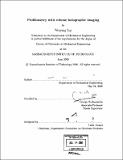Profilometry with volume holographic imaging
Author(s)
Sun, Wenyang
DownloadFull printable version (13.91Mb)
Other Contributors
Massachusetts Institute of Technology. Dept. of Mechanical Engineering.
Advisor
George Barbastathis.
Terms of use
Metadata
Show full item recordAbstract
High resolution, non-contact object profile measurement (profilometry) at long working distance is important in a number of application areas, such as precise parts manufacturing, optical element grounding and polishing, adversary target identification in military, terrace profiling, etc. The Volume Holographic (VH) lens is a novel optical element which process the incident light field in a 3D fashion. It has been shown with promising applications in object profile acquisition and 3D imaging areas. In this thesis, we propose, design and implemented a number of volume holographic computational imaging systems for profilometry related applications. We show that the rich functionalities of the VH lens can be exploited to process the incident optical field. Some of the unique imaging behavior can not be easily achieved by using conventional optics. We first develop the theoretical framework for investigating the VH lens optical behavior. We concentrate on a simple design: using the VH lens as the spatial spectrum plane filter in a 4F imaging system. We derived the point spread function (PSF), the depth resolution, the diffraction field distribution of the proposed imaging system. Experimental system characterization and profilometry measurements were carried out with our setups. (cont.) We find the resolution of the volume holographic imaging (VHI) profilometry system degrades quadratically with the increase of working distance. We addressed this problem by two approaches: 1. We discuss the effect of objective optics design on the VHI resolution. We proposed and implemented the use of appropriately designed telephoto objective optics to achieve very good resolution at long working distance. 2. We developed a maximum likelihood estimation based post-processing method to improve the depth resolution by more than 5 times. An important issue on VHI profilometry is the "slit-shaped" limited field of view (FoV). This makes measurement over the entire big object is very time consuming because scanning is necessary. Otherwise hundreds or thousands of VH lenses must be multiplexed on a single crystal to concatenate the slit FoV of each VH lens to form a wide exit window. However the multiplexing method suffers the "M/#" penalty on photon efficiency. We solved this problem by utilizing the wavelength degeneracy of the VH lens and designed a rainbow illumination VHI to expand the FoV. (cont.) We also extended the application of VHI to hyper-spectral imaging. The experimental implementation of the hyper-spectral imaging system shows it is capable of not only reconstructing the 3D spatial profile but also restoring the spectral information of the object, both at high resolution. Finally, we conclude with some directions for the future work in this emerging field.
Description
Thesis (Ph. D.)--Massachusetts Institute of Technology, Dept. of Mechanical Engineering, 2006. Includes bibliographical references (p. 127-133).
Date issued
2006Department
Massachusetts Institute of Technology. Department of Mechanical EngineeringPublisher
Massachusetts Institute of Technology
Keywords
Mechanical Engineering.